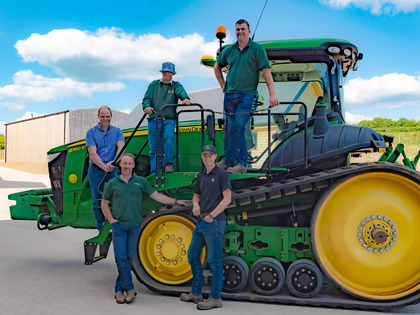
When Craig Livingstone took over managing a 1100 ha farm between Stockbridge and Salisbury in Hampshire, one of the first things he did was become a NIAB TAG member. But why?
Here Craig tells us about the farm he manages, and just why NIAB TAG membership is right for him.
Four years ago, Craig took over managing the Lockerley Estate farm in Hampshire. Prior to that he was an Agronomist.
‘Coming from an agronomy background, I knew how well respected NIAB are in the industry. So I became a NIAB TAG member, as I wanted a forum where we could look at trials, get access to the results and meet farmers. NIAB offered all of that, so it was an easy decision to join’ says Craig.
The Farm
Five miles outside Stockbridge, and near to Salisbury, sits Lockerley Estate, owned by the Sainsbury family.
Craig is part of a small team and they largely do everything themselves: ‘I believe in training our own staff rather than buying the expertise in, apart from NIAB TAG membership, of course!’
Craig adds: ‘The total area farmed, including contract farms, is 1100 ha. Of this the majority, around 800 ha, is under arable cropping, with a 215 ha woodland working forestry business. There is a huge variety in soils on the farm – around half the farm is Hampshire chalk, but there is also some heavy clay cap. The remaining area is used for livestock, with 1000 sheep on site.
The sheep are used as a tool in our system to manage cover crops, which allows natural fertility building and significant reduction in glyphosate use. 30% of the farm is under some form of conservation management.’
Conservation
Craig uses a seven-year rotation and is always looking to improve soil health and fertility. He believes that it’s about the overall value of rotation rather than individual crop. OSR is now unviable on the estate due to the area historically grown. Battling huge brassica weed problems and early signs of clubroot combined with 100% resistant CSFB, Craig opts for two-year fertility building clover grass leys.
It all stems from the landowners – the Sainsbury family – and their vision for the farm underpins everything: it has to be sustainable and resilient but equally doing the right thing must pay. It recently became a LEAF demonstration farm.
How does being a NIAB TAG member support this?
‘The best thing is the dialogue with other farmers’ says Craig. ‘The opportunity to have discussions and talk through different options is helpful – I’m not alone! I can pick up the phone and talk to other farmers in a similar situation.
‘I like getting the strategy options. I feel that it empowers me to make decisions without actually selling me something. It’s invaluable – if you divide the cost across the hectarage of my farm, it’s definitely worth it. It gets me looking at things in different ways and you get a lot of data and knowledge.’
How has being a NIAB TAG member impacted your farm?
Craig estimates that membership has helped him reduce pesticide spend by 22%, and fungicides by 13%. ‘It gives us the confidence to be brave, we can pick the right variety for our farm and then match it to the right agronomy. I like the risk scorecard we are sent. It’s very useful to go through it and see where your variety is and what you’d spend on a crop. You can then change it if you feel there is a more suitable one for you.’
What would you say to someone who is considering becoming a NIAB TAG member?
‘Do it! The value for what you get is unrivalled.’
If Craig has inspired you, then why not try NIAB TAG membership for free for 90 days.
This article appeared in Landmark, the NIAB TAG members magazine and was originally published in March 2020.
